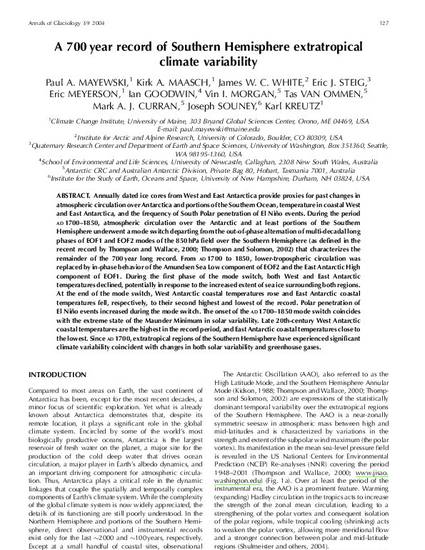
Article
A 700 Year Record of Southern Hemisphere Extratropical Climate Variability
Annals of Glaciology
Document Type
Conference Proceeding
Rights and Access Note
This Item is protected by copyright and/or related rights. You are free to use this Item in any way that is permitted by the copyright and related rights legislation that applies to your use. In addition, no permission is required from the rights-holder(s) for educational uses. For other uses, you need to obtain permission from the rights-holder(s).
Publication Date
1-1-2004
Disciplines
Abstract/ Summary
Annually dated ice cores from West and East Antarctica provide proxies for past changes in atmospheric circulation over Antarctica and portions of the Southern Ocean, temperature in coastal West and East Antarctica, and the frequency of South Polar penetration of El Nino events. During the period (AD) 1700-1850, atmospheric circulation over the Antarctic and at least portions of the Southern Hemisphere underwent a mode switch departing from the out-of-phase alternation of multi-decadal long phases of EOF1 and EOF2 modes of the 850 hPa field over the Southern Hemisphere (as defined in the recent record by Thompson and Wallace, 2000; Thompson and Solomon, 2002) that characterizes the remainder of the 700 year long record. From (AD) 1700 to 1850, lower-tropospheric circulation was replaced by in-phase behavior of the Amundsen Sea Low component of EOF2 and the East Antarctic High component of EOF1. During the first phase of the mode switch, both West and East Antarctic temperatures declined, potentially in response to the increased extent of sea ice surrounding both regions. At the end of the mode switch, West Antarctic coastal temperatures rose and East Antarctic coastal temperatures fell, respectively, to their second highest and lowest of the record. Polar penetration of El Nino events increased during the mode switch. The onset of the AD 1700-1850 mode switch coincides with the extreme state of the Maunder Minimum in solar variability. Late 20th-century West Antarctic coastal temperatures are the highest in the record period, and East Antarctic coastal temperatures close to the lowest. Since AD 1700, extratropical regions of the Southern Hemisphere have experienced significant climate variability coincident with changes in both solar variability and greenhouse gases.
Citation/Publisher Attribution
Mayewski, PA, Maasch, KA, White, JWC, Steig, EJ, Meyerson, E, Goodwin, I, Morgan, VI, et al., 2004, A 700 Year Record of Southern Hemisphere Extratropical Climate Variability: Annals of Glaciology, Vol 39, 2005, v. 39, p. 127-132. Available on publisher's site at: http://www.ingentaconnect.com/content/igsoc/agl/2004/00000039/00000001/art00020
Publisher Statement
© Copyright 2004 by the International Glaciological Society
DOI
10.3189/172756404781814249
Version
publisher's version of the published document
Citation Information
Paul Andrew Mayewski, Kirk A. Maasch, J W.C. White, E. J. Steig, et al.. "A 700 Year Record of Southern Hemisphere Extratropical Climate Variability" Annals of Glaciology Vol. 39 (2004) p. 127 - 132 Available at: http://works.bepress.com/karl_kreutz/10/
